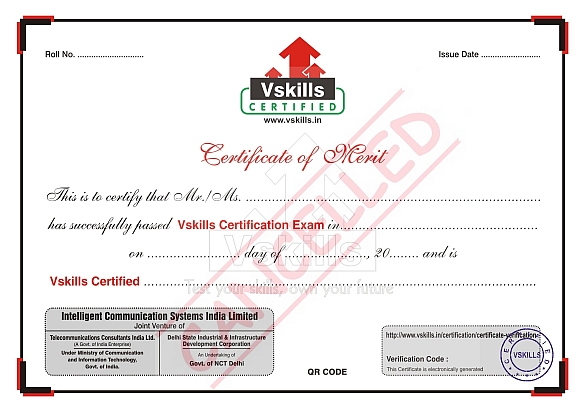- Duration / Course length: 1 To 2 Months Start now
- Certificates:
- Course delivery: This course is delivered in video format
Course details
Vskills certification for Warehouse Manager assesses the candidate as per the company’s need for warehousing of goods and products to be stored as per the company’s requirements. The certification tests the candidates on various areas in warehouse management, which include the knowledge of various warehouse processes and operating principles, functions of different picking equipments and strategies to employ them, application of order picking methods, usage of various storage and handling equipments, relevance of health and safety, role of computers and warehousing management system, controlling warehousing costs, performance management for warehouse and outsourcing.Why should one take this certification?
This certification is intended for professionals and graduates wanting to excel in their chosen areas. It is also well suited for those who are already working and would like to take certification for further career progression.
Earning Vskills Warehouse Manager Certification can help candidate differentiate in today's competitive job market, broaden their employment opportunities by displaying their advanced skills, and result in higher earning potential.
Who will benefit from taking this certification?
Job seekers looking to find employment in Logistic companies, MNCs, PSUs or public sector companies, consumer goods and manufacturing companies or warehouse or store department of various companies, students generally wanting to improve their skill set and make their CV stronger and existing employees looking for a better role can prove their employers the value of their skills through this certification.
Table of Contents
Role of a Warehouse
- Introduction
- Benefits of Warehousing
- Functions of Warehouses
- Need for Holding Stock
- Characteristics of Warehouses
- Warehousing Efficiency and Effectiveness
- Information and Technology Requirements
- Measuring Performance
- Introduction
- Challenges for Warehouse Managers
- Attracting and Retaining Warehouse Employees
- Ageing and Constantly Changing Workforce
- Employee Training
- Introduction
- Receiving
- Pre-receipt
- In-handling
- Preparation
- Offloading
- Checking
- Cross Docking
- Recording
- Quality control
- Put-away
- Warehouse Design
- Types of Warehouses
- Warehouse Location
- Planning the Distribution Warehouse
- Warehouse Layout
- Qualitative Factor Rating Method
- Introduction
- Picker to Goods
- Goods to Picker
- Automated Picking
- Material Handling Equipment
- Storage Equipment
- Introduction
- Industry Trends Affecting Order Picking
- Modern Order Picking Systems
- Stock Profiling
- Order Picking Alternatives
- Order Picking Strategies
- Pick-To-Light Systems
- Paper Pick Lists
- Pick by Label
- Pick by Voice
- Barcode Scanning
- Radio Frequency Identification
- Pick by Light/Pick to Light
- Put to Light
- Type of Picking System and Equipment
- Replenishment
- Value Adding Services
- Stock Management
- Stock or Inventory counting
- The Annual count
- Security
- Returns Processing
- Dispatch
- Role of Driver in Transportation
- Introduction
- WMS Requirement
- Other Functionality/Considerations
- Why does a company need a WMS?
- Advantages of WMS
- Choosing a WMS
- Selection Process
- Software as a service
- Introduction
- Requirement for a Redesign
- Design Approach
- Warehouse Design
- Storage Systems
- Pallets
- Automated storage and retrieval Systems (AS/RS)
- Temperature-Controlled Storage
- Storage of Packaged Dangerous Substances
- Types of costs
- Return on investment (ROI)
- Traditional versus Activity Based Costing Systems
- Activity based Costing for Multi-Principals
- Calculating Warehouse Storage Costs
- Logistics Charging Methods
- Why should one outsource?
- Outsourcing Decision
- Role of Third Party Contractors
- Choosing the Right Partner
- Managing Third Party Relationship
- Why contracts with third party fail?
- Future of Outsourcing
- Introduction
- Environmental Effects
- Environmental Impact Assessment Tool
- The Environment Model
- Flow chart of Green Logistics
- Steps to for Improvement





